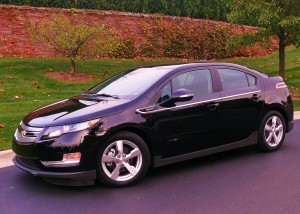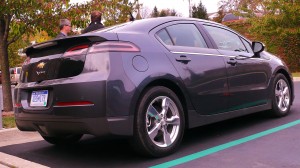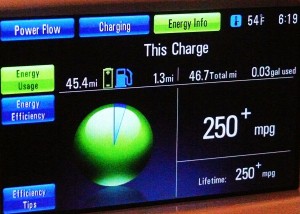Chevy Volt performance? Electrifying!
By John Gilbert
ROCHESTER, MICH. — We’ve all heard about the Chevrolet Volt, through five years of hyperbole and breathless promotion. But finally, Chevrolet’s plug-in electric car is ready to start production as a 2011 model, with a few prototypes already hitting the streets and highways. First drive experiences indicates it might be better than the most enthusiastic claim from the always enthusiastic staff that remains in the rebuilt General Motors.
The Volt might inspire a brave new world in automotives, and it certainly could become the vanguard indicating that Chevrolet and GM could return to automotive technical prominence. The Volt is sleekly styled, somewhere between compact and subcompact size. It’s heavy, because its primary drive system is a battery pack and two electric motors, along with its backup gas engine. And, it’s expensive, costing just over $40,000 and probably fetching closer to $43,000 after production gets going by the end of November.
Several waves of automotive journalists got to drive the Volt extensively barely a week before Halloween 2010, which might be appropriate, because the Volt’s operation borders on being spooky — but very, very impressive — compared to conventional cars. Fortunately, Pam Fletcher, the chief engineer on global Voltech and plug-in electric vehicles for GM, gave a thorough presentation that provided answers to almost all questions.
As a “plug-in” electric car, General Motors has steadfastly maintained the Volt is NOT a hybrid. A lot of us, cynics by now, figure that along with its sophisticated battery pack, the Volt does have a little 4-cylinder gasoline engine, which comes on when the electrical supply is drained from the battery pack, similar to the Toyota Prius hybrid. The Honda system is more integrated in blending the electric/gasoline power, as is Ford.
There is a surprising difference, however, which wasn’t sprung on us until we actually were able to drive the car, visit the Detroit/Hamtramck assembly plant where it is made, and fill our brains to overflow with all the technical wonders Chevrolet engineers have been accruing over the last five years. That is, the gas engine comes on and powers the car alone — which the Toyota hybrid system will not do — but it only powers the Volt; Essentially, you drive the Volt on electric-only power until the neat little dashboard-screen imagery indicates you’ve used it all up, then the little gas engine comes on. But let’s put it all into real-world perspective.
I met the Chevrolet troops at the Detroit Metro Airport, where they put me into the driver’s seat of a Volt and, luckily, placed Martin Krueger, Volt’s program manager, in the passenger seat next to me. He explained things as we went along, toward our destination, which was the Royal Park Hotel in suburban Rochester, 20 miles north of Detroit, and 46.7 miles north of the airport. I know the distance, because I got 45.4 miles on the battery alone, before the gas engine got us the final 1.3 miles.
Electric power is far more potent than gasoline engine power, so maximum power hits immediately. Engage the gear knob to drive, although it also has “low,” then step on the “gas” pedal, and without so much as a “whoosh,” you’re moving. We zipped around the airport exit road, and headed onto I-94 East toward Detroit, veering north on I-75, before the necessary zigging and zagging up the suburban streets to Rochester. The Volt accelerated quickly, handled lane-changing moves with smooth agility, and held the road with precision, and it could never be accused of lagging in traffic. A truck-driver at a red light yelled to ask us how we liked the Volt and if it was available yet. I yelled back that we were very impressed and that it would be out in about two months. Then the light changed to green, and we sped away, leaving the truck-driver startled, I’m sure, as we were suddenly a half-block ahead.
Scott Miller, who is in charge of product development, provided an interesting evaluation of how consumers might view all the technical intricacies. “A lot of people don’t want to know how a watch was made,” he said, “they just want to know what time it is.”
Good words to remember, although I had already driven delicately, the way I always do when I’m driving a hybrid, because it’s fun to see how high you can push the fuel economy gauges. You can switch to three driving control settings, but I found the normal setting to be just fine, although the sport setting provides much quicker throttle response.
Martin Krueger, the perfect person to give me little tips about instruments and controls, switched the dash screen to show two round balls, which give you tips about operation of the vehicle and the driver. The left ball shows how efficiently you are driving. When we started out, it showed 14 percent, but I got it up quickly to 50 and 60, and before we were halfway there, I had it up to 100-percent driving efficiency.
We made the final turn, and we were just over a mile from our hotel when Krueger said, “You see the gauge shows we’re down to zero in battery power. Now it will switch over to ‘Range Extending,’ which is the traction engine.”
In the real world, we’ll call it the gasoline engine, but GM always has loved its euphemisms. The gas engine would have extended my range indefinitely, but all we needed was 3.1 miles, then I pulled into the hotel parking area and parked in a prescribed slot in the ramp. I opened the door, hit the switch for the filler door, then hopped out and grabbed a large electrical nozzle, plugging it into the socket inside the car’s open filler door, which is located just ahead of the driver’s door. A light came on atop the dashboard, indicating we were engaged. It would take four hours at 240 volts, or 10 hours at 120 volts, and the Volt would be completely recharged. An accessory with the car is a coil-up adaptor cord that will convert household 120 to 240, and you can carry it under the hatchback for charging at work, or on a trip.
On the dashboard, the computer showed I had attained “250+” miles per gallon. The indicator only goes to 250, so anything over that is just counted as “plus.” That’s fantastic fuel economy, but it figures, since I used absolutely no gasoline for 45.4 miles, and then used only a thimble-full of gas — 0.03 gallons to be exact — to cover the rest.
There aren’t any actual EPA estimates yet, because how can it be estimated? All tests indicate that the Volt’s battery-power range is between 25-50 miles, so a better estimate would be for full-charge range, plus another estimate on fuel economy from the gas engine, which only is pressed into duty after the battery power is depleted.
General Motors figures most people drive less than 40 miles a day going to work or back. If you live less than 20 miles from work, you can drive a Volt to work, park it, and drive it home, then plug it in overnight. Theoretically, you could keep that up indefinitely and never use a pint of gasoline, let alone a gallon. One Chevrolet engineer said he’s been test-driving a Volt for four months, and only filled the fuel tank once. In 700 miles of use, he’s used 7 gallons of premium fuel.
The next day, we teamed up and drove to the assembly plant where they build the Cadillac DTS, Buick Lucerne and now the Volt. The route to the plant and back to the hotel was purposely long enough to run all the Volts out of battery power, so we could experience “Range Extended” driving. The Volt will go to a governed maximum speed of 100 on electric power, and it moves adequately if not with sportiness on the gasoline engine — which is a 1.4-liter, dual-overhead-camshaft engine, with a cast iron block and cast aluminum heads. Continuously variable valve timing on its four-valves per cylinder helps produce 83 horsepower — or a peak of 62 kilowatts through the generator — at 4,800 RPMs.
The battery pack system sounded vaguely familiar, and when engineers explained it was actually a “lithium ion polymer” set-up, rather than lithium ion, and that it was a joint venture with electronics giant LG, I recalled that the new Hyundai Sonata Hybrid uses an LG-coordinated battery pack system that is lithium ion polymer, also.
In the Volt, the fourth major design phase from LG produced the desired power. There are 288 lithium ion cells, in three banks of 96 cells, producing 360 volts each. They are connected in a large “T” shape that is 5.5 feet long, with the shaft of the T running between the four bucket seats, and the crossing shaft under the rear seat area. The whole thing weighs 435 pounds, and it is mounted on strong structural braces under the middle of the car, which weighs nearly 4,000 pounds. The pack produces 103 kilowatts of power.
Pam Fletcher explained the technicalities of how different clutches engage and disengage a ring gear, which regulates whether battery power runs the drive wheels, or battery power augmented by power generated by the gas engine under hard acceleration, or if only the gas engine’s generated power takes over for the extended range after the battery juice is depleted. The gas engine also acts as a generator, sending power to the inverter on the battery-pack side. A buffer, which retains a bit of electrical power for emergency purposes such as to get you a short distance more if you deplete battery and gas power, is maintained by the gas engine’s generated power.
“The Range Extender is aimed at maintaining the buffer, not to recharge the battery pack,” Ms. Fletcher said. “The traction engine can put torque directly into the ring gear, but only in the presence of electrical power. The Volt is always powered by electrical input, either totally or partially through the Range Extender.”
She added that the Volt powerplant has been tested in extreme heat and cold, and amended another engineer’s statement that the battery pack requires constant cooling, with cooling fins between every pair of the thinly aligned cells, but that it would never need to be heated. In overview, heat is bad for battery life and cold is bad for battery performance. She acknowledged that even in the coldest temperature tests in Kapuskasing, Ontario, engineers needed to put the pack in a freezer, or blow colder air at it with a fan, for thorough testing. When I mentioned Minnesota’s occasional dips to 20 or 30 below, maybe for several days and nights in a row, she said, “We could heat the system in severe cold.”
The system is warrantied for 8 years or 80,000 miles, although it is projected to last more than 150,000 miles.
My biggest question was why the gas engine doesn’t at least supply some recharging to the battery pack. The Volt, as is, would be a fantastic urban car, but some cynics said you’d need another car if you ever wanted to take a family trip. If you were going to drive for eight hours, from Minnesota to the western end of South Dakota, for example, you’d deplete the battery pack in the first half-hour, then you would face the rest of the trip on the little gas engine. It’s capable, but your mileage would probably drop from my 250-plus to 165, then to something more like 40 mpg at sustained highway speed. With some charging, perhaps you could go back to use battery power again, after a few hours of gas-powered driving.
Turns out, there is a “mountain” switch, which allows the system to raise the buffer and save you some power, recharging up to 45 percent full capacity, in case you feel you need more power for the highest climbs. That’s similar to the European Volt’s “hold” switch, prompting the system to use more gas-engine power and save battery power on the highway, allowing drivers to enter cities that tax any and all vehicle emissions and drive on pure electric for their time in town.
But such things are major nitpicks, considering the enormity of the technical breakthrough that the Volt represents. There are other pure-electric cars coming out right now, too, such as the Nissan Leaf, which doesn’t have a gas engine at all. But right now, the Volt’s high price buys a technological marvel that could change the way we drive, and the way we demand our cars operate in the future. The first buyers may even change the cliche, because as analogies go, those people who ask Volt owners what time it is really DO want to know how the watch works.
Comments
Tell me what you're thinking...
and oh, if you want a pic to show with your comment, go get a gravatar!






 John Gilbert is a lifetime Minnesotan and career journalist, specializing in cars and sports during and since spending 30 years at the Minneapolis Tribune, now the Star Tribune. More recently, he has continued translating the high-tech world of autos and sharing his passionate insights as a freelance writer/photographer/broadcaster. A member of the prestigious North American Car and Truck of the Year jury since 1993. John can be heard Monday-Friday from 9-11am on 610 KDAL(www.kdal610.com) on the "John Gilbert Show," and writes a column in the Duluth Reader.
John Gilbert is a lifetime Minnesotan and career journalist, specializing in cars and sports during and since spending 30 years at the Minneapolis Tribune, now the Star Tribune. More recently, he has continued translating the high-tech world of autos and sharing his passionate insights as a freelance writer/photographer/broadcaster. A member of the prestigious North American Car and Truck of the Year jury since 1993. John can be heard Monday-Friday from 9-11am on 610 KDAL(www.kdal610.com) on the "John Gilbert Show," and writes a column in the Duluth Reader.